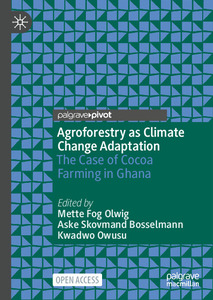| dc.contributor.author | Boadi, S.A. |
| dc.contributor.author | Bosselmann, A.S. |
| dc.contributor.author | Owusu, K. |
| dc.contributor.author | Asare, R. |
| dc.contributor.author | Olwig, M.F. |
| dc.date.accessioned | 2024-03-20T11:14:38Z |
| dc.date.available | 2024-03-20T11:14:38Z |
| dc.date.issued | 2024 |
| dc.identifier.citation | Boadi, S.A., Bosselmann, A.S., Owusu, K., Asare, R. & Olwig, M.F. (2024). Household economics of cocoa agroforestry: costs and benefits. In M.F. Olwig, A.S. Bosselmann and K. Osusu, Agroforestry as climate change adaptation: the case of cocoa farming in Ghana. London, UK: Palgrave Macmillan, (p. 121-146). |
| dc.identifier.isbn | 978-3-031-01329-4 |
| dc.identifier.uri | https://hdl.handle.net/20.500.12478/8444 |
| dc.description.abstract | Current research suggests that cocoa agroforestry systems could offer stable yields, additional benefits and income from shade trees, despite potential added costs, such as from the purchase of insecticides. There is a paucity of profitability studies of different cocoa agroforestry systems. Only few of them go beyond a narrow focus on cocoa yields to model the entire agroforestry system and thus do not advance our understanding of the socio-economic value of other ecosystem goods. Based on survey data covering a thousand cocoa plots and group interviews with cocoa farmers, we explore the costs and benefits at the household level of including trees in cocoa systems. Comparing low and medium tree
diversity systems, we find that income from cocoa beans, timber and fruit trees are higher and labour costs are lower in plots with medium diversity, while insecticide costs are lower on low-diversity plots. Overall, net benefits were higher on cocoa plots with higher tree diversity. Thus, cocoa agroforestry systems offer cost-reduction and income-improving advantages. Since cocoa systems vary among different agro-ecological zones in Ghana, we recommend that interventions aimed at increasing tree diversity consider the specific management practices of each farming household and the location in question. |
| dc.format.extent | 121-146 |
| dc.language.iso | en |
| dc.publisher | Palmgrave Macmillan |
| dc.subject | Cocoa |
| dc.subject | Agroforestry |
| dc.subject | Agrobiodiversity |
| dc.subject | Households |
| dc.subject | Economics |
| dc.subject | Profitability |
| dc.subject | Income |
| dc.subject | Diversification |
| dc.title | Household economics of cocoa agroforestry: costs and benefits |
| dc.type | Book Chapter |
| cg.contributor.crp | Climate Change, Agriculture and Food Security |
| cg.contributor.affiliation | University of Ghana |
| cg.contributor.affiliation | University of Copenhagen |
| cg.contributor.affiliation | International Institute of Tropical Agriculture |
| cg.contributor.affiliation | Roskilde University |
| cg.coverage.region | Africa |
| cg.coverage.region | West Africa |
| cg.coverage.country | Ghana |
| cg.coverage.hub | Headquarters and Western Africa Hub |
| cg.researchtheme | Natural Resource Management |
| cg.authorship.types | CGIAR and developing country institute |
| cg.iitasubject | Agribusiness |
| cg.iitasubject | Agronomy |
| cg.iitasubject | Climate Change |
| cg.iitasubject | Cocoa |
| cg.iitasubject | Farming Systems |
| cg.iitasubject | Food Security |
| cg.iitasubject | Forestry |
| cg.iitasubject | Socioeconomy |
| cg.publicationplace | London, UK |
| cg.accessibilitystatus | Open Access |
| cg.reviewstatus | Peer Review |
| cg.usagerightslicense | Creative Commons Attribution 4.0 (CC BY 0.0) |
| cg.targetaudience | Scientists |
| cg.identifier.doi | https://doi.org/10.1007/978-3-031-45635-0_5 |
| cg.iitaauthor.identifier | Richard Asare: 0000-0001-6798-7821 |
| cg.futureupdate.required | No |

